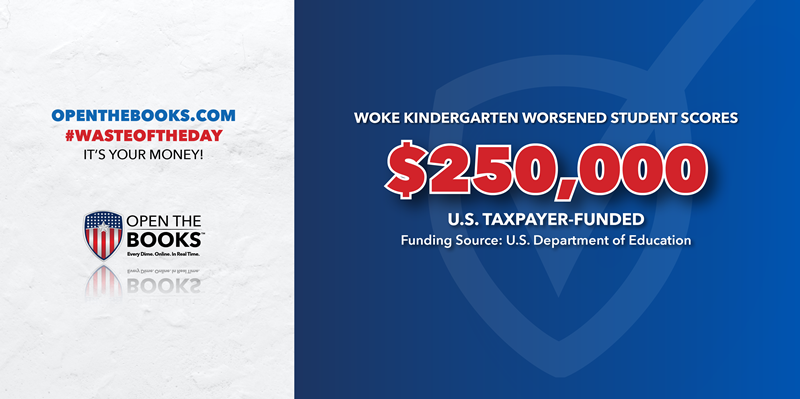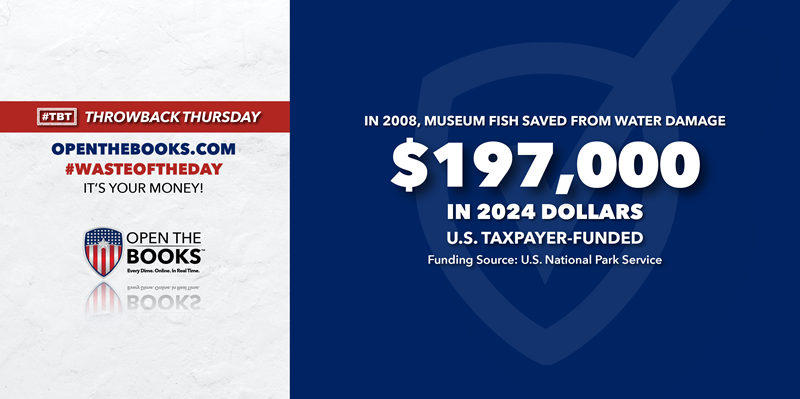
Smithsonian Mismanaged $7.5 Million In Covid Funds
March 18, 2024

Topline: The Smithsonian Institution received $7.5 million to respond to Covid-19, but the museum and research complex spent some of those funds on unrelated items and potentially overpaid for other supplies, according to a new Inspector General report.
Key facts: The IG audited 64% of the Smithsonian’s money from the 2020 CARES Act and found that the museum “did not consistently spend … funds in accordance with applicable laws, policies, and procedures.”
In July 2020, the Smithsonian said it urgently needed to hire a doctor to assist with Covid procedures. The institution paid him a $214,465 salary with CARES Act funds.
Museum staff claimed that 95% of the doctor’s work was related to the pandemic, but records revealed that only 6% of his appointments involved Covid-19.
Smithsonian staff also spent $29,000 on items unrelated to Covid-19. Purchases included water fountains, printing supplies and even a phone case.
The institution is required to collect offers from multiple companies when buying something over $10,000 to find the best price. But the Smithsonian only accepted bids on three of its 12 largest purchases, meaning $1.5 million was spent without a “fair and reasonable” price.
The Smithsonian violated the same procedure when spending $503,000 on face masks and hand sanitizer.
The museum then failed to report a quarter of its spending to the Federal Procurement Data System, which is supposed to let the public view government purchases. The spending was accurately reported to sister website USASpending.gov.
Smithsonian staff said the errors were simple mistakes and agreed to improve internal controls.
Background: The Smithsonian isn’t the first federal entity to get caught wasting CARES Act funds. The Pentagon spent $53.2 million on ineligible items, and the Paycheck Protection Program spent $29 billion and counting on improper payments.
Now that the pandemic is over, the Smithsonian has found a new way to spend money: boosting its own payroll.
In 2020, there was only one person at the Smithsonian making more than $200,000. Last year, there were 44 such employees, according to the database at OpenTheBooks.com.
Summary: Fittingly, the Smithsonian has now become part of the history it preserves as the latest federal agency to misuse its Covid-19 funding.
California 'Woke Kindergarten' Blew Money On Odd Curriculum, High Pensions
March 19, 2024

Topline: A California school spent $250,000 in federal funds to hire a teacher training service called Woke Kindergarten, but after two years, student performance got even worse, according to the San Francisco Chronicle.
An audit by researchers at OpenTheBooks.com revealed that almost two-thirds of employees at the low-income, underperforming Glassbrook Elementary are making six-figure salaries. Retired educators are also collecting pensions of more than $200,000.
Key facts: Woke Kindergarten’s website says it supports “children, families, educators and organizations in their commitment to abolitionist early education and pro-black and queer and trans liberation.”
The teacher-training program is designed to help students “resist, heal, liberate and create.” It was paid for through a federal grant meant to help the country’s lowest-performing schools.
Glassbrook Elementary said it terminated Woke Kindgergarten’s contract earlier this year because the for-profit group’s public statements “did not align” with the school’s values.
Founder Akiea Gross recently said in an Instagram video that the U.S. and Israel are both “demons” and “villains” that have “no right to exist” because of their treatment of Native Americans and Palestinians.
Glassbrook Elementary still defended its decision to hire Woke Kindergarten. The Chronicle says district officials claimed the school was no longer on the state watch list for low performance, only to be told their ranking on the list had actually gotten worse.
The California Department of Education is required by law to monitor how low-performing schools use federal funds. That means the department either approved the $250,000 Woke Kindergarten contract or did not follow proper oversight procedures.
U.S. Senator Bill Cassidy (R-LA), who leads the Senate Health, Education, Labor and Pensions Committee, recently opened an investigation into Woke Kindergarten and the California Department of Education’s oversight of Glassbrook Elementary.
Background: Less than 4% of students at Glassbrook Elementary are proficient in math and only 12% can read at grade level. The school is in a low-income community where two-thirds of students are English learners and 80% are Hispanic.
But records from OpenTheBooks.com show that in 2022, when Woke Kindergarten was hired, the Hayward Unified School District spent almost $136 million on payroll, including doling out six-figure salaries to 814 educators — 60% of all employees.
Superintendent Matthew Wayne made $295,000 that year, $80,000 more than California Gov. Gavin Newsom.
The district also paid $5 million in pensions in 2022. Eighty-one retirees collected six-figure pensions up to $211,248.
Supporting quote: A school spokesperson told Fox News “Anti-bias/Anti-racist teaching, restorative practices, multi-language learning, literacy and mathematics will remain a focus for Glassbrook, building on the work that school has undertaken over the past several years.”
Summary: Regardless of one’s opinion on diversity education in schools,a perhaps $250,000 is better used to teach first-graders to read and write instead of tackling global politics.
Coast Guard Boats Are Behind Schedule, Over Budget
March 20, 2024

Topline: Two new kinds of boats being built for the Coast Guard are years behind schedule and will cost a combined $12.9 billion more than expected, according to a new report from the Government Accountability Office.
Key facts: The Coast Guard is developing 25 Offshore Patrol Cutters and three Polar Security Cutters to replace outdated boats. They were originally supposed to cost $63.8 billion to acquire and maintain until they are no longer usable.
But after delays and redesigns, new projections say the boats will actually cost $76.7 billion.
The Coast Guard ordered the first 25 boats in 2012. The boat is designed for long distances and can launch airplanes and other boats.
Partially because of a “manufacturing error with a key component of the propulsion system,” the boats will now be delivered in late 2024 with a lifetime cost of $64.6 billion. That’s three years late and $10.6 billion more than projected.
The Coast Guard also chipped in another $659 million to build the ships after the manufacturer’s facilities were damaged in a hurricane — which the GAO called “extraordinary contractual relief.”
The polar boat is designed for icy waters in the Arctic and Antarctic.
Those will also be delivered three years late in June 2027 because of an “immature design” that is still only 46% finished after four years of work. There are also supply shortages from the pandemic and the war in Ukraine.
The shipbuilders had a “lack of experience” with designing icebreakers and made calculation errors about their size. The polar boats will now be larger than expected and cost an extra $2.3 billion.
Background: These aren’t the only two Coast Guard boats whose price tag is rising behind the scenes.
Every year, the Coast Guard and other military agencies must submit a “wish list” to Congress of items they want funded in addition to their normal budget.
Auditors at OpenTheBooks have been investigating these wish lists. The Coast Guard requested an extra $1.6 billion in 2024, mostly to fund several kinds of cutter boats — some of which won’t even be built for another 10 years.
That includes $100 million to store the Offshore Patrol Cutters at a new pier in Rhode Island.
Summary: The Coast Guard says the Offshore Patrol Cutters are their “highest investment priority,” but there appears to be no limit on the size of that investment.
Throwback Thursday: Federal Grant Saves Giant Stuffed Fish
March 21, 2024

Throwback Thursday!
Topline: Critics of government spending often claim there are bigger fish to fry than the issues our tax dollars support.
That was not the case in 2008, when the federal government spent $135,000 to repair the world’s largest stuffed fish in a Long Island museum.
The project cost $197,000 in 2024 dollars.
The stuffed fish was highlighted in the “Wastebook” reporting published by the late U.S. Senator Dr. Tom Coburn. For years, these reports shined a white-hot spotlight on federal frauds and taxpayer abuses.
Coburn, a U.S. Senator from Oklahoma, earned the nickname "Dr. No" by stopping thousands of pork-barrel projects using the Senate rules. Projects that he couldn't stop, Coburn included in his oversight reports.
Coburn's Wastebook 2008 included 65 examples of outrageous spending worth more than $1.3 billion, including the $135,000 taxidermy expense.
Key facts: The 32-foot stuffed whale shark had been on display at Suffolk County’s Vanderbilt Museum until it was ruined by water damage, of all things. Leaky plumbing forced the museum to remove the display for 12 years and nearly throw away the shark.
The National Park Service gave taxidermist David B. Schwendeman $135,000 to repair the fish, but that wasn’t enough. Suffolk County gave Schwendeman a similar amount, Newsday reported.
The federal dollars came from the Save America’s Treasures Grants program, which has spent over $300 million on 1,300 grants since 1998.
The museum is located in the former mansion of William K. Vanderbilt II, who bought the 8-ton whale shark after it was caught off Fire Island in 1935. The fish exhibit reopened exactly 73 years later, with support from taxpayers.
Supporting quote: "I think of taxidermy as the ultimate in terms of conservation and wise use of our natural resources,” Schwendeman told Newsday. “Trying to save this, being considered one of America's treasures — probably the world's largest mounted fish, maybe the largest piece of taxidermy in the world — I felt it was worthy of saving."
Summary: The 32-foot whale shark had once belonged to one of the richest men in history. Yet somehow, taxpayers were still on the hook for $135,000 to save a fish after it got wet.
Debt Held By The Public Will Be “Unsustainable” By 2050
March 22, 2024

Topline: The U.S. debt held by the public is expected to more than double during the next 26 years until it reaches an “unsustainable” amount, according to a new study from the Government Accountability Office.
Key facts: Debt held by the public was $26.2 trillion in September 2023, about the same as the U.S. gross domestic product. That means our debt is growing at the same pace as the economy.
Debt held by the public measures everything the government owes to those outside the government. It’s slightly different from the $34 trillion national debt but is usually considered more meaningful because it does not include money that federal agencies owe to other parts of the government.".
But the GAO expects the debt held by the public to reach a record 108% of GDP in 2028. By 2050, the U.S. debt will be twice its GDP unless spending decreases.
The current record for debt was 106% of GDP in 1946 — right after WWII — and it was only about 25% in 2000.
The debt increases when the government spends more money than it collects and borrows to make up the difference. This has happened every year since 2008, and the federal deficit has surpassed $1 trillion for the last four years.
The GAO outlines several issues the rising debt might cause. The public could lose faith in the government’s credit and stop buying Treasury bonds, which would affect government revenue and lead to “drastic tax increases.”
Workers’ wages could fall, decreasing income tax collection and forcing the government to borrow even more money.
As more money is borrowed, interest payments will take up a greater share of federal spending, forcing the government to either borrow even more or start spending less on programs like Social Security and Medicare. Interest spending is expected to pass $1 trillion by 2029, even more than the U.S. will likely spend on the military that year.
Background: Last May, researchers at OpenTheBooks prepared testimony on the federal debt for the Senate.
OpenTheBooks called on the federal government to decrease the debt by limiting spending, not by increasing taxes.
Several opportunities for reform exist. The government mistakenly makes over $250 billion in “improper payments” every year. Almost half of unemployment benefits in 2020 were likely stolen.
Even with tax revenue at an all-time high, government debt continues to grow exponentially.
Critical quote: Former Chairman of the Joint Chiefs of Staff Michael Mullen once famously said that “the most significant threat to national security is our debt.”
Summary: For years, politicians have been able to spend government money and defer the debt crisis to future leaders. Soon, that will no longer be an option.
The #WasteOfTheDay is presented by the forensic auditors at OpenTheBooks.com.